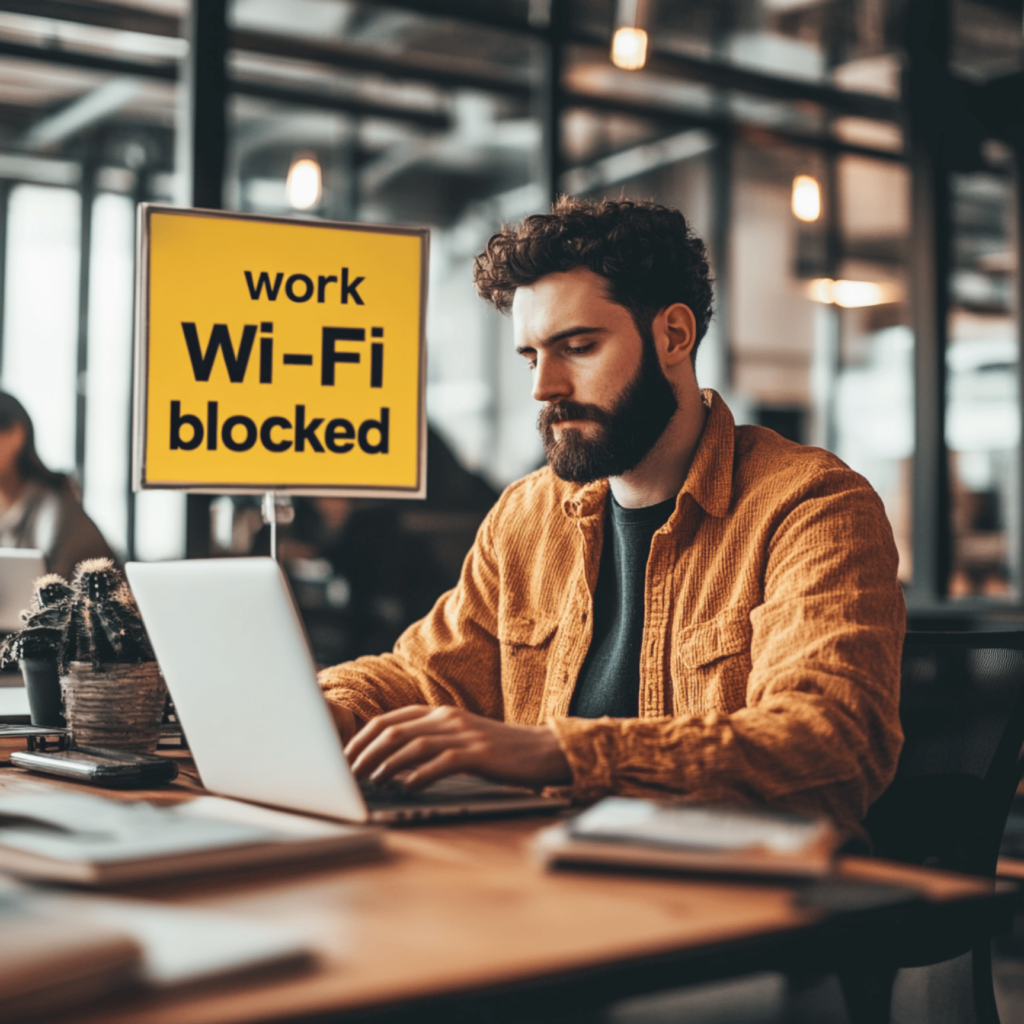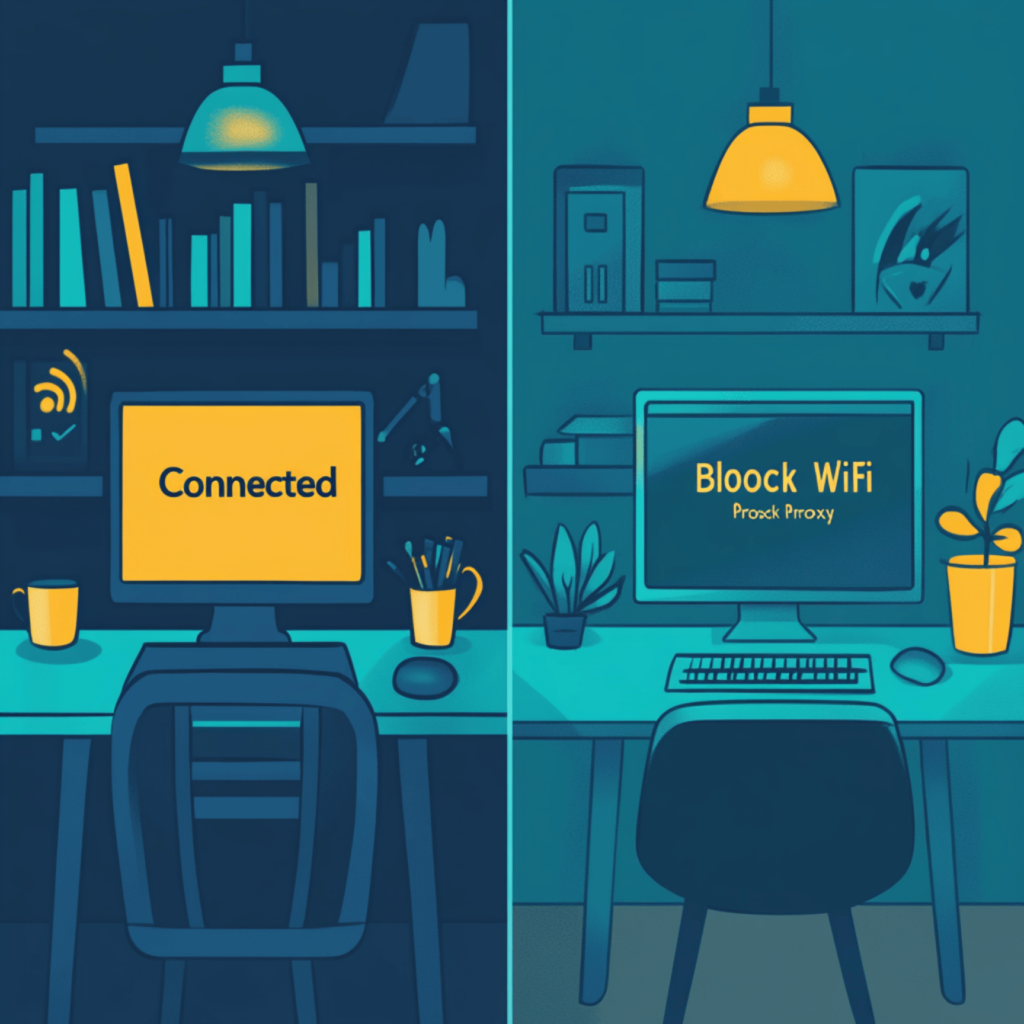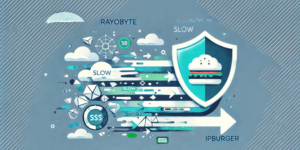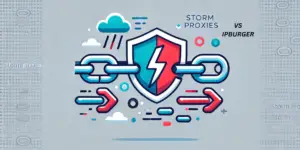You’re sitting at school, trying to check Instagram. Blocked. Or maybe you’re at work, hoping to stream a video on your break. Blocked again.
Annoying, right?
Schools and workplaces love locking down their Wi-Fi. Social media, streaming, gaming—they block it all. They say it’s for productivity, but sometimes, you just need to access a website for research, or maybe… a little downtime.
Here’s the good news: you don’t have to live with those restrictions. There’s a simple, effective way around them—proxies. These little tools can help you bypass network filters and unlock the web without anyone being the wiser.
In this guide, we’ll show you step-by-step how to use proxies to bypass school and work Wi-Fi restrictions. Whether you’re a student needing a break or an employee trying to access legitimate content (we won’t judge), we’ve got you covered.
What Are Proxies and How Do They Work?
Think of a proxy as a middleman for your internet connection. Normally, when you access a website, your device connects directly to it, sending out your IP address—basically your digital fingerprint. But when you use a proxy, that connection goes through a different IP address first. The website sees the proxy’s IP instead of yours. This makes proxies a powerful solution for those who need to know how to bypass school and work Wi-Fi restrictions using proxies.
It’s like wearing a disguise. Only, instead of a mustache and sunglasses, it’s an IP address from somewhere else entirely.
Why does this matter?
Because schools and workplaces block certain sites by identifying where the traffic is coming from. When you use a proxy, they can’t easily trace the connection back to you or your network, allowing you to slip through the cracks.

Proxies vs. VPNs: What’s the Difference?
While proxies reroute your traffic, a VPN (Virtual Private Network) does that and encrypts your data. Think of a VPN as a proxy on steroids—it offers extra security but can sometimes be slower. That’s why proxies are often a better fit for quick tasks like bypassing a school or work filter without needing heavy encryption.
The key takeaway?
Proxies are fast and lightweight, perfect for getting around those pesky network restrictions without slowing you down.
Why Are They So Effective?
About 60% of businesses globally block social media on their networks, and schools often do the same to “reduce distractions” (how dare they) . Proxies help you avoid these blocks by making it seem like your connection is coming from a completely different place.
In other words, you get access while the network remains none the wiser.
Types of Proxies You Can Use to Bypass Wi-Fi Restrictions
Not all proxies are created equal. Some are fast but risky, others are slower but more secure. Choosing the right one depends on how strict the network restrictions are and how stealthy you need to be. When learning how to bypass school and work Wi-Fi restrictions using proxies, you’ll want to pick the right proxy for your situation.
Let’s break down your options.

Residential Proxies: The VIP Pass
Residential proxies are the gold standard. Why? Because they come from real IP addresses—those assigned to actual homes by internet service providers (ISPs). This makes them look legitimate, so they’re far less likely to be detected and blocked by school or work networks. The best option for those wondering how to access blocked websites at school or work, as they come from real IP addresses and are much harder for network admins to detect.
In fact, residential proxies are so reliable that even websites with advanced filters (we’re looking at you, Netflix) struggle to block them.
If you’re trying to get past heavy-duty restrictions, this is your go-to option.
When to Use Them:
- Schools with strict firewalls that block everything from Facebook to news sites.
- Workplaces where they’re serious about limiting non-work-related browsing.
Datacenter Proxies: Fast but Detectable
Fast, but more easily detectable. These are a decent option if speed matters more than stealth, though they may not be the best if you’re dealing with strict filters when learning how to bypass school and work Wi-Fi restrictions using proxies.
If you need speed and don’t mind the small risk of detection, these proxies can get the job done. Just be aware that school or work networks might catch on quicker with these.
When to Use Them:
- For accessing non-sensitive sites like YouTube or Reddit, where speed matters more than stealth.
- In environments with weaker network filters.
Public Proxies: Free but Risky
Free sounds good, right? Not in this case. Public proxies are free to use, but they’re also… well, pretty sketchy. They’re often overloaded with users, making them slow and unreliable. Worse, since anyone can use them, they’re more likely to be blocked by networks.
These can help you access blocked websites at school, but the lack of security makes them a less ideal choice overall.
Plus, let’s not forget the security risks. Public proxies can be hotspots for hackers, and the last thing you need is someone snooping on your internet activity while you’re trying to get past a school filter.
When to Use Them:
Honestly? Almost never. Unless you’re absolutely desperate, avoid public proxies.
ISP Proxies: The Hybrid Solution
ISP proxies give you the best of both worlds. They’re hosted in data centers but assigned by ISPs, which makes them look like residential proxies while delivering datacenter speeds. It’s like having a secret identity—fast, reliable, and hard to detect.
When to Use Them:
- In high-stakes scenarios where you need both speed and stealth (think: bypassing serious restrictions during exams or at a corporate office).
- For long-term use, where both anonymity and performance matter.
By now, you’ve got a solid sense of which proxy type fits your situation. Just remember, the tighter the restrictions, the more likely you’ll need a residential or ISP proxy to get through.
And if speed is more your thing? Datacenter proxies might be your best bet.

Step-by-Step Guide to Using Proxies to Bypass School and Work Wi-Fi Restrictions
Now that you’ve chosen the right type of proxy, let’s get into the fun part: setting it up and getting past those Wi-Fi restrictions. Don’t worry—it’s easier than you think.
Step 1: Choose a Reliable Proxy Provider
The first step in how to bypass school and work Wi-Fi restrictions using proxies is to find a good provider.FThis isn’t the place to cut corners. Free proxies might seem tempting, but as we mentioned earlier, they can be slow, unreliable, and downright unsafe.
Look for a provider that offers residential, datacenter, or ISP proxies—whichever suits your needs best. IPBurger, for example (shameless plug), is a reliable option that’s perfect for bypassing network filters, offering both speed and stealth.
Pro Tip: Make sure the provider has proxies in multiple locations. This gives you more flexibility to switch IPs if one gets blocked.
Step 2: Configure Your Device to Use the Proxy
Once you’ve picked a provider, you’ll need to set it up on your device. Whether you’re on a laptop or mobile device, the process for setting up a proxy and accessing blocked websites at school or work is pretty straightforward.
For Windows:
- Go to “Settings” and click on “Network & Internet.”
- Click “Proxy” on the left-hand menu.
- Under “Manual Proxy Setup,” toggle the switch to “On.”
- Enter the proxy server’s IP address and port (provided by your proxy provider).
- Save your settings.
For Mac:
- Open “System Preferences” and click on “Network.”
- Select your active network connection and click “Advanced.”
- Go to the “Proxies” tab and check the type of proxy you’re setting up (usually HTTP or HTTPS).
- Enter the proxy server’s IP address and port.
- Click “OK” and apply the settings.
For iOS (iPhone or iPad):
- Open “Settings” and tap “Wi-Fi.”
- Tap the info button (the little “i” next to the Wi-Fi network you’re connected to).
- Scroll down to “HTTP Proxy” and select “Manual.
- Enter the proxy server’s IP address and port.
- Save the settings and exit.
For Android:
- Go to “Settings” and tap “Wi-Fi.”
- Long press the network you’re connected to and select “Modify Network.”
- Scroll down to “Advanced” and tap on “Proxy.”
- Choose “Manual” and enter the proxy server’s IP and port.
- Save your changes.
Step 3: Test Your Proxy Connection
After setting up, make sure everything works smoothly. This is a crucial part of learning how to bypass school and work Wi-Fi restrictions using proxies, as you want to ensure your IP is properly masked.
- Use a site like whatismyip.com to check your IP address. If it shows the IP address of your proxy and not your actual location, you’re good to go.
- If your connection seems slow or some sites still don’t load, you might want to try a different proxy or switch to a proxy from a different location.
Pro Tip: Some networks monitor unusual traffic. To avoid raising any red flags, keep your browsing patterns natural—don’t go too wild with the multiple streams and downloads all at once.
Step 4: Enjoy Your Unrestricted Browsing
You’re all set! Now you can browse freely without the annoyance of those pesky blocks. Whether you’re sneaking a quick look at Instagram between classes or catching up on the latest episode during lunch, proxies make it possible.
And the best part?
Your school or workplace has no idea what you’re up to.
Using VPNs vs. Proxies: Which is Better for Bypassing Wi-Fi Restrictions?
If you’re trying to decide whether to use a proxy or a VPN, both can help with how to bypass school and work Wi-Fi restrictions using proxies, but they have some differences. Proxies are faster and better for simple website access, while VPNs offer encryption that keeps your data more secure. But for most users just trying to access blocked websites at school or work, proxies tend to be faster and more efficient.
Proxies: Lightweight and Fast
Proxies, as we’ve discussed, are great for quick tasks. They reroute your internet traffic through an alternative IP address, hiding your real location from the school or work network. However, they don’t offer any encryption, which means your traffic is still visible to anyone monitoring the network—just with a different IP.
When Proxies are Best:
- You need fast access to sites like YouTube or Instagram.
- Security isn’t your main concern, and you just want to get past the blocks.
- Your school or work network isn’t super strict about tracking data—just blocking sites.
In short: proxies are the fastest and simplest solution for bypassing filters. They get the job done without slowing you down.
VPNs: The Security Powerhouse
A VPN (Virtual Private Network), on the other hand, does everything a proxy does but adds a layer of encryption. When you use a VPN, your data is encrypted before it leaves your device and goes through the VPN server. This means that even if someone is monitoring the network, they can’t see what you’re doing—they just know you’re connected to a VPN.
That added encryption makes VPNs slower than proxies, but also far more secure.
When VPNs are Best:
- You’re dealing with sensitive information or don’t want anyone tracking your browsing history.
- Your school or workplace uses deep packet inspection (DPI) to monitor what you’re doing online.
- You need access to restricted content from different regions (VPNs can be better at getting around geo-blocks).
Fun Fact:
According to a survey, around 31% of internet users worldwide have used a VPN to access restricted content. VPNs are particularly popular among younger users (aged 16-24) who want more control over their internet privacy .
Smart DNS: The Quick Alternative
If neither proxies nor VPNs feel like the right fit, there’s one more option—Smart DNS. This service changes your DNS address (like a phonebook for the internet) to make it appear as if you’re in a different location. Smart DNS doesn’t encrypt your data, so it’s faster than a VPN but still offers a way to bypass geo-restrictions.
When Smart DNS is Best:
- You need access to streaming services blocked on your school or work Wi-Fi.
- Speed is your top priority, but you don’t need encryption.
Which One Should You Choose?
If speed is your biggest concern and you’re only trying to bypass basic website blocks, proxies are your best bet. They’re quick, easy to set up, and perfect for accessing sites like social media or YouTube.
But if you want to keep your browsing completely private, or you’re working in an environment with heavy monitoring, a VPN will give you peace of mind with its encryption.
And if you’re looking for an alternative to both? Smart DNS might be worth a try for streaming or region-specific content.

Advanced Proxy Configurations for School and Work Wi-Fi
Now that you’ve got the basics down, it’s time to level up your proxy game. In some cases, basic proxy configurations might not be enough—especially if your school or workplace is using more advanced network monitoring or restrictions. Let’s dive into some advanced configurations that can give you the extra edge when bypassing filters.
Rotating Proxies: Stay One Step Ahead
Most schools and workplaces don’t just block websites—they keep an eye on repeated requests from the same IP address. This is where rotating proxies come into play. With rotating proxies, your proxy server will automatically change the IP address at regular intervals, making it much harder for network administrators to detect or block your connection.
Think of it like switching disguises in the middle of a heist. One minute, you’re in a trench coat. The next? A hoodie. And no one knows it’s the same person.
Here’s how to set it up:
- Use a Proxy Rotation Service: Many proxy providers (including IPBurger) offer proxy rotation features. All you need to do is configure your bot or browser to switch between proxies at preset intervals.
- When to Use Rotating Proxies: When you’re accessing sites that make frequent connections (like streaming services or large downloads), or when you want to reduce the chances of getting blocked for using a single IP too many times.
Pro Tip:
Set the rotation intervals based on your activity. For lighter browsing, rotating every 10-15 minutes is enough. For more intense activity (like multiple downloads), rotate every 2-3 minutes.
Geo-Targeting Proxies: Bypass Regional Blocks
Some schools or workplaces restrict access to websites based on geographic location. For example, a company might block access to sites that aren’t relevant to their region. Enter geo-targeting proxies. These proxies make it appear as if you’re accessing the internet from a completely different location—whether that’s across the country or across the globe.
How to Set It Up:
- Choose proxies from a different region or country, especially if your school or work restricts access to certain regional content.
- Your proxy provider should offer proxies in various locations (e.g., US, UK, Europe, etc.).
When to Use Geo-Targeting:
- You’re trying to access region-specific content, like news sites or videos, that are restricted in your current location.
- Your school or workplace blocks websites based on geographic location.
Proxy Chains: Layering for Extra Anonymity
For those dealing with the most advanced firewalls or network monitoring systems, you can take it a step further by using a proxy chain. This involves routing your traffic through multiple proxies, so even if one proxy is compromised or detected, the others will continue to hide your original IP address.
It’s like going through a maze with a secret exit that keeps shifting as you move through it.
How It Works:
- Your connection passes through multiple proxies before reaching its final destination. Each proxy in the chain adds a layer of protection by masking the previous IP address.
When to Use a Proxy Chain:
- You’re dealing with highly restrictive environments that constantly monitor for proxy usage.
- You need extra security and anonymity (perhaps to access more sensitive or heavily blocked websites).
Pro Tip:
While proxy chains offer added protection, they can slow down your connection. Use them only when absolutely necessary.
What to Do If Your Proxy Gets Detected or Blocked
Even with the best proxies, there’s always a chance that your school or workplace might catch on and block your connection. But don’t panic—this isn’t the end of the road. There are several ways to troubleshoot and get back online.
Why Do Proxies Get Blocked?
Networks block proxies for several reasons:
- Repetitive Requests: If too many requests are coming from the same IP address, it can trigger suspicion.
- Known Proxy IPs: Some schools and workplaces use databases that flag commonly used proxy IPs.
- Advanced Firewalls: More sophisticated firewalls can detect proxy usage by analyzing traffic patterns.
When this happens, you might see messages like “Access Denied” or experience sudden disconnects from the proxy server.
How to Switch Proxies When Blocked
If your proxy gets blocked, switching to a new one is often the quickest fix. Here’s how to do it:
- Use a New Proxy: Simply replace your current proxy with another IP from your provider. Most proxy services, like IPBurger, offer a range of IPs to choose from, so you’re never stuck with just one option.
- Rotate Your Proxies: If you aren’t already using rotating proxies, now’s the time to switch. By constantly rotating your IP addresses, you reduce the risk of getting flagged.
- Switch Proxy Types: If you’re using a datacenter proxy, try switching to a residential or ISP proxy. These are harder to detect and more likely to bypass filters.
Try a Different Location
If a particular IP address or range is blocked, it’s often because the network has flagged that region. Changing your proxy location can help bypass these blocks.
- How to Do It: Access your proxy provider’s dashboard and select a different geographic location. Then update your proxy settings on your device.
Pro Tip: Choose a region that’s less likely to have restrictions, like a proxy from a neighboring country or a less-known city.
Use an Encrypted Proxy or VPN
Sometimes, the problem isn’t just the proxy IP—it’s the visibility of your traffic. If your school or workplace is using advanced firewalls that analyze traffic patterns, switching to an encrypted proxy or a VPN might be necessary.
- VPN to the Rescue: VPNs hide not only your IP address but also encrypt your data, making it harder for the network to see what you’re doing. This extra layer of security is useful if proxies alone aren’t cutting it.
Clear Your Browser Cache and Cookies
Sometimes the simplest fix is the best one. Cached data and cookies can store information about your previous sessions, and if those were flagged, you might be blocked even with a new proxy.
How to Clear Cache and Cookies:
- For Chrome: Go to Settings > Privacy and Security > Clear Browsing Data. Select “Cookies and other site data” and “Cached images and files.”
- For Firefox: Open Menu > Options > Privacy & Security > Clear Data.
After clearing the cache and cookies, restart your browser and connect to your proxy again.
When All Else Fails, Try a Different Method
If proxies keep getting blocked and no amount of switching IPs or locations is helping, it might be time to try a different method altogether. Consider switching to a VPN or Smart DNS service, both of which offer alternative ways to bypass network filters.
Security and Privacy Concerns When Bypassing Wi-Fi Restrictions
When you’re bypassing school or work Wi-Fi restrictions, it’s not just about getting access to blocked websites—it’s also about staying safe and protecting your privacy. After all, using proxies or VPNs means you’re redirecting your internet traffic through a third-party server, and you want to make sure your data stays secure.
Let’s break down the key security and privacy concerns and how to address them.
Avoid Free or Public Proxies—Always
Free proxies might seem like an easy fix, but they’re riddled with risks. Since these proxies are public, they often have:
- Overloaded Servers: Too many users on the same IP leads to slow speeds and a higher likelihood of detection.
- Lack of Encryption: Many free proxies don’t encrypt your data, leaving your personal information and browsing activity exposed to hackers or prying eyes.
- Malicious Intent: Some free proxy providers are known for tracking user data and selling it to advertisers—or worse, cybercriminals.
According to a study by the Commonwealth Scientific and Industrial Research Organization (CSIRO), over 84% of free proxies engage in some form of malicious activity, including intercepting traffic or injecting ads.
The takeaway? Stick with a trusted, paid proxy provider. It’s worth the small investment to keep your information safe and secure.
Use Secure Proxies (SSL/HTTPS Proxies)
When choosing proxies, opt for those that support SSL (Secure Socket Layer) or HTTPS (Hypertext Transfer Protocol Secure). These proxies encrypt your data, ensuring that even if someone tries to intercept your traffic, they won’t be able to read it.
Why This Matters:
- School Networks: Even if you’re just trying to bypass basic filters, schools may monitor internet traffic for unusual activity. SSL proxies help prevent this by encrypting everything you do.
- Work Networks: Employers may track browsing activity to ensure it’s in line with company policies. Using SSL proxies ensures your browsing remains private.
Choose Proxies with a No-Logging Policy
When using proxies, your internet traffic is routed through their servers, which means they could theoretically log everything you do. To protect your privacy, choose a proxy provider that explicitly states it has a no-logging policy. This means they don’t keep records of your browsing activity, so even if someone requested your data, there would be nothing to hand over.
How to Check:
Reputable proxy services like IPBurger make their no-logging policies clear on their websites. Always check the privacy policy before purchasing.
Legal and Ethical Considerations
Okay, let’s be real for a moment: while bypassing network restrictions might be tempting, there are some legal and ethical considerations to keep in mind.
- At School: Many schools block certain websites for a reason. Bypassing these restrictions could violate school policies and lead to disciplinary action. Always weigh the risks before proceeding.
- At Work: Companies often block sites to maintain productivity and protect sensitive data. Accessing blocked websites could breach company policies, and in some cases, could result in warnings or job termination. Ensure you understand your employer’s rules before circumventing their network restrictions.
Pro Tip: If you need access to a blocked website for legitimate purposes (like research or work-related tasks), it’s often best to discuss this with your network administrator rather than trying to bypass restrictions without permission.
Keep Your Device Secure
Bypassing Wi-Fi restrictions opens up access to the wider internet, but it also exposes you to potential threats. Here’s how to stay protected:
- Use Antivirus Software: Ensure your device is protected from malware, especially if you’re downloading files or accessing unfamiliar websites.
- Enable a Firewall: A firewall adds an extra layer of protection, keeping unwanted traffic from entering your device.
- Stay Updated: Keep your operating system, browser, and any security software up to date. This helps protect against vulnerabilities that hackers could exploit.
When using proxies (or any method to bypass network restrictions), security and privacy should always be top of mind. Avoid free proxies, stick with SSL/HTTPS proxies, and make sure your provider has a no-logging policy to keep your browsing safe. And remember: bypassing restrictions comes with responsibilities—make sure you’re aware of any rules or risks involved.
Conclusion
So, you’re no longer stuck staring at that “Access Denied” message, wondering why your school or work Wi-Fi hates fun. With proxies, you’ve got the keys to the digital kingdom, and now you know how to use them.
Whether you’re sneaking in a little Instagram scroll during lunch or genuinely trying to access blocked research, proxies can be your best friend. They’re fast, lightweight, and—if you’ve been paying attention—easy to set up.
Now that you’re armed with everything you need to bypass those pesky restrictions, it’s time to put it all into practice. Need a reliable proxy? You know where to find IPBurger. We’ve got you covered.
Happy surfing, and don’t let the filters get you down.
FAQs
How can I unblock social media on school Wi-Fi?
To unblock social media, the easiest way is to use a proxy or VPN. Proxies change your IP address, making it appear like you’re browsing from a different location—outside of your school’s restrictions. Just configure a reliable proxy (like a residential or ISP proxy) and you should be able to access Instagram, Facebook, or whatever’s blocked. Keep it subtle, though—don’t go overboard and draw attention to your activity.
Can my school or workplace detect if I’m using a proxy?
Yes, it’s possible. Schools and workplaces use network monitoring tools to detect unusual traffic patterns, which can sometimes reveal proxy use. However, rotating proxies or using residential proxies can reduce your chances of being detected. If you need added protection, using a VPN is a more secure option since it encrypts your traffic, making it harder to track.
Is it illegal to use proxies at school or work?
Using proxies is not illegal in most cases, but it could violate your school or workplace’s policies. If they have strict rules against bypassing network restrictions, you could face disciplinary action if caught. Always be mindful of the consequences and consider whether accessing blocked content is worth the risk.



